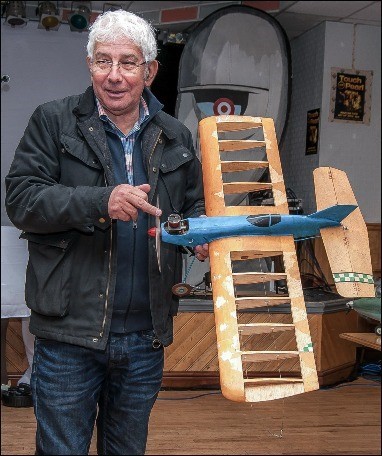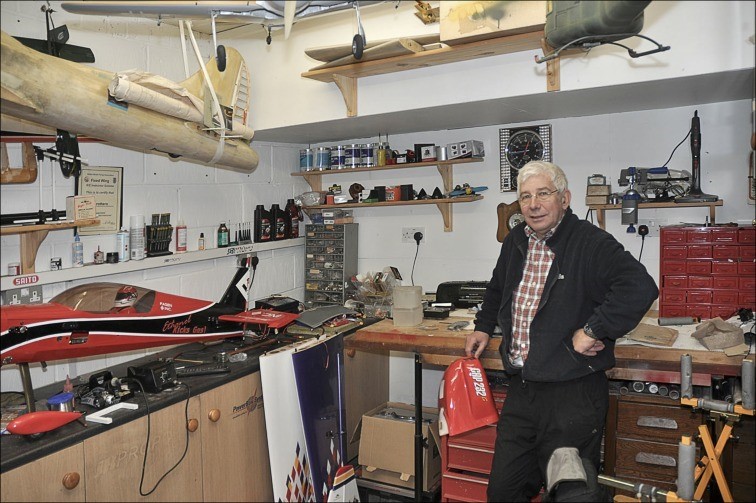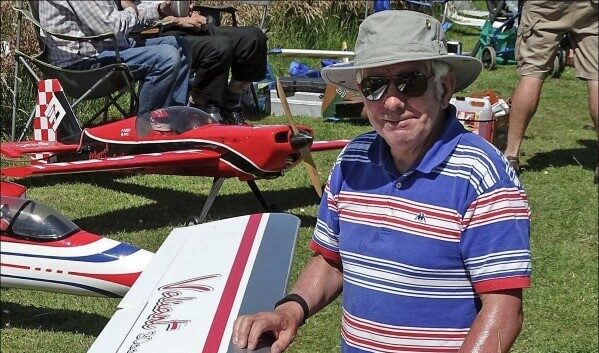
You must all know by now that the club has recently lost one of our longest-serving members to a degenerative motor-neurone condition. John’s loss has come as a bit of a shock to many of us who have had the pleasure of knowing him for many, many years. We have all, stored away, a multiplicity of stories told by John (as well as lots of stories about him!). I’m going to attempt to put together a few of the more memorable anecdotes. For this I am indebted to Chris Vernon and Jim Sheldon for searching their memory banks.
Chris first came across JP (as he was affectionately called by many of us) about 1980 when Chris was learning to fly on the site, that was then in use, at the football pitches off Lawson Road. Chris notes that, whatever he did, John always had advice ready to tell him how he should have done it. John also told him that he flew the wrong mode on his transmitter – John flew mode 1. Sensibly, Chris had the wit to ignore him and still flies mode 2 to this day.
John, being the life-long modeller that he was, built some first-class models. One of which was a Chris Foss Acrowot. Now, at this time, I had been experimenting with glass cloth finishing of models with K&B “Superpoxy” resin and lightweight glass cloth that I had imported from New Mexico. John had picked up on this and had elected to finish his Acrowot in SP113 resin, which he informed me was “much better” (it wasn’t!). If memory serves me correctly, he originally got the mix wrong or picked a day with too much humidity in the air. Whatever the cause, the resin did not set. John being John, triumphed over this adversity and produced a really nice Acrowot, with a painted finish, which was pulled along by a Laser 70 four-stroke. Let me now revert back to Chris’s memory to pick up the tale with this model…
John was always one for spectacle and innovation and had come up with an idea for a smoke system for his model. From an army surplus store John had purchased a supply of red distress flares, one of which he had strapped to the underside of the Acrowot. With the model set to go, Chris had the task of pulling the tag to fire the flare, so that John could do an immediate take-off. Now, the Acrowot was very low-slung, so Chris had to pick the model up to get to the tag. It was at this point that a degree of trepidation set in: the flare had printed on it a skull and crossbones, and words such as “Nato Approved” and “Military use only”. Brave as a lion, Chris pulled the tag, triggering instant action from the flare! With red smoke billowing everywhere, a hurried take-off was made: the red smoke looked very good in the sky. On landing the pair of them were covered in red dye, as was the model. Forever afterwards that model had a pronounced pink tinge. John used to tell folk that it was probably due to the action of UV on the paint!
One clear and frosty flying morning, John had brought his Webra 90 powered Cranfield A1 out for some exercise. He called a low pass and approached the strip at about ten degrees – an attitude the model held until it hit the runway! The model, skidding across the frozen ground, slid a long, long way, shedding model bits as it did so. John conducted a thorough, post-crash investigation and concluded that the likely cause of the crash was the effect of the low temperature on his JR radio. A few days later, Chris received a rather muffled phone call. It was from John who had his radio, and his head, in his freezer testing the equipment under cold conditions. He blamed the radio, but it was probably battery failure.
You are probably getting a picture of the man: capable, innovative and ready to push the boundaries. He also had another string to his bow – he was a self-proclaimed expert with horses. Read on kind reader…
Picture the scene: the club was running a flying event, on our old flying site to the rear of Blackpool Zoo. We had been fortunate to obtain the loan of a marquee for the day – a huge olive-green thing that weighed half a ton. Unfortunately, on arriving at the field, the members found that some “travellers” (I think that’s what John called them) had picketed a couple of horses a bit too near to the marquee and the proposed flying area. Now these were not the sort of horses that one might see between the pages of a Thelwell tome. These equine specimens would not have looked out of place between the shafts of a brewer’s dray! Members stood around debating what to do when, lit by the rising sun, the Fylde’s only horse whisperer appeared…
Now, Chris tells me that his wife knows a thing or two about horses, and she says that the correct way to approach a strange horse is from the front, so that the beast may sniff one’s hand. The horse whisperer approached from behind, arms outstretched, whispering the magic phrase “come on horsey, move”. The horse, feigning indifference, continued to munch the grass. The whisperer came nearer… and into range. With unexpected swiftness, the beast delivered an iron-shod blow to the side of the whisperer’s head. John was down and out.
When members rushed over, John was muttering something about seeing stars and hearing bells ringing in his head. Being the caring, sharing club that we are, it was decided to ferry our hero over to Victoria hospital. By this time the perfect shape of a large horse shoe was developing in yellow and purple on the side of John’s head. The caring members then left him there and dashed back to the flying field so as to enjoy the event! On their return, the horses had been removed.
As a corollary, at the next AGM, John was presented with a mounted horse shoe in the “special awards” section of the prize-giving.
John, being a life-long modeller, was known to a great many people. This became apparent to Jim when the pair of them shared a trip to the Nationals. After an entertaining drive down, they had not been there for more than thirty minutes before roughly twenty people had come up to John for a chat (Jim was impressed!). After initiating Jim into the intricacies of control line speed, the duo made their way to the trade stands. To Jim’s surprise, John bought an elderly, battered, free-flight model – John was only interested in the little diesel engine and intended to bin the airframe. The little model eventually found its way into the back of the car but not before Jim had poked his fingers through the tissued wing “so as to make it easier to carry” (!) As the day waned towards evening, the pair made their way over to the free-flight area…
This branch of the hobby proved a bit of an eye-opener for Jim. He does not recall which particular event was taking place but he was mesmerised by the quality of the models present and all the accoutrements to success on display (wind detectors, and the like). Nearly all the models flown took off, executed a sharp turn and either strafed the spectators or crashed. After an hour or so of this, John dragged a bemused Jim back to the car where he retrieved the model and, muttering “let’s give this a go”, strode back to the flight-line. The lad cadged some sellotape to repair the wing and, with some borrowed diesel fuel, coaxed the engine into life. A series of engine-off test glides over the long grass followed with John sellotaping small stones to the model to adjust the CG. He quickly pronounced himself satisfied. With a cheeky “can I give this a go, mister” he licked his finger, stuck it in the air, then started the ancient engine, gave it a quick fettle and released the model. (Jim didn’t know where to look!) The model took off beautifully and performed many large circuits in its climb to great height. When just a dot in the sky, the motor stopped and the model started to descend, gracefully, to a decent landing. The assembled multitude had just witnessed the best flight of that free-flight event. The cheering was both loud and sustained. John did not win, of course, because he was not officially entered, but he had provided a spectacle that would be long remembered. As a post-script, John and Jim had enjoyed the day so much that they came back for more fun and games the very next day.
I too have memories of John. He was famous for his long, involved tales. John would call me, often just as I had mixed a batch of epoxy or was half way through painting a wing. Sometimes he would call from his bath – sounds of splashing and quacks from his plastic duck ever audible. Some of his stories were hardly believable but, somehow, always proved to be true: John never failed to surprise. A couple of years ago, at Christmas time, we ran into John at Barton Grange. We did not bat an eye when we saw that he was carrying a three foot tall acrylic, illuminated penguin! He said it was for the shop, but I’m not sure that we totally believed him.
John is, sadly, no longer with us but he will always be remembered as a larger-thanlife personality, a committed club member and someone who could make an ordinary day special.
Good bye, old friend…
John Higgins




